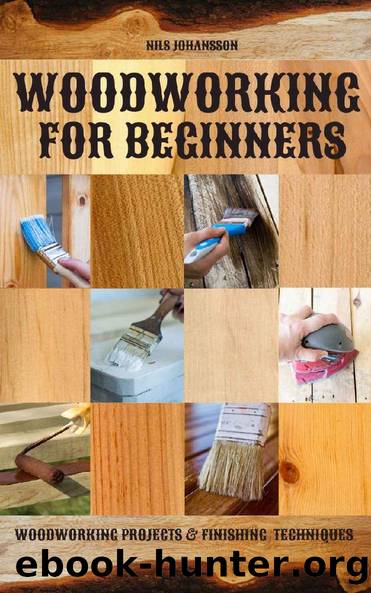Woodworking for Beginners: Woodworking Projects & Finishing Techniques by NILS JOHANSSON & NILS JOHANSSON

Author:NILS JOHANSSON & NILS JOHANSSON [JOHANSSON, NILS & JOHANSSON, NILS]
Language: eng
Format: epub
Published: 2020-05-25T00:00:00+00:00
The air cap in a spray gun controls the velocity of the air, which governs how finely the fluid is atomized. Air caps with smaller holes cause the air to leave the gun at a higher velocity, therefore producing finer atomization.
Air caps are matched with fluid tips to give optimum performance. Most guns come equipped with a standard setup appropriate for several finishes. The setup includes a fluid tip that's about 0.5 in. dia. and a corresponding air cap.
The standard setup will develop acceptable results with most finishes, but from time to time it's worth trying other combinations of fluid tips and air caps.
In a turbine-driven HVLP system, the amount of air feeding the gun is continuous, so adjustments to the air pressure can only be done by changing air caps.
If you are using a waterborne finish with a turbine and a bleeder-type gun, ensure that the nozzle stays clean. These guns are prone to blobs of finish drying on the air cap and then blemishing the work.
Spray guns come with adjustments for air and fluid. The type of finish being sprayed, the size of the object to be coated, and the speed of application all play a role in deciding how to control the fluid and air.
I always test my fan pattern and finish delivery rate on scrap wood or cardboard so that I can make adjustments before I actually spray the piece.
Adjusting a turbine powered spray gun is a simple procedure: No matter what type of gun you own, the idea is to start air flowing through the gun first, and then introduces finish slowly until it flows continuously and evenly.
The gun should apply a full, wet coat with no heavy spots or misses. From this point, you can open or close either knob to obtain the best spray rate and fan pattern.
If you want to spray a lot of material in a hurry, open the fluid control more. If you are coating large surfaces, widen the fan pattern.
If you're trying to achieve a fine finish or you're spraying small items, you'll have more control of how much finish is applied and where it lands by restricting the fan and fluid.
But remember, how you set one knob affects the other. For example, if you increase the air flow without adjusting the fluid, the finish may be too fine.
Conversely, opening the fluid control without widening the fan can cause runs and sags. At the ideal settings, the finish will coat evenly and flow together well.
With high pressure spray guns and conversion-air HVLP guns, both powered by a compressor, you have the ability to control the air pressure entering the gun in addition to adjusting the fluid rate and fan shape.
Getting all three adjustments coordinated can be a bit tricky and takes some trial and error, but being able to regulate the air pressure at the gun allows more spraying options.
Irrespective of the size and shape of the object you're spraying, the main thing to keep in mind is that you want to spray an even coat over the entire piece.
Download
This site does not store any files on its server. We only index and link to content provided by other sites. Please contact the content providers to delete copyright contents if any and email us, we'll remove relevant links or contents immediately.
Home Recording For Dummies by Jeff Strong(948)
The Chicken Bible by America's Test Kitchen(912)
Pinch of Nom Quick & Easy by Kay Featherstone & Kay Featherstone(827)
Wheat Belly by MD William Davis(756)
Beginners by Tom Vanderbilt(752)
Tiny Houses: The Perfect Tiny House, With Tiny House Example Plans (Tiny Houses, Tiny House Living, Tiny Homes, Tiny Home living, Small Home, Small Houses, Tiny House Plans, Small House Plans Book 1) by Christopher Dillashaw(751)
To Asia, With Love by Hetty McKinnon(724)
A Year at the Chateau by Dick Strawbridge & Angel Strawbridge(719)
Quick and Delicious by Gordon Ramsay(710)
The Little Book of Life Skills: Deal With Dinner, Manage Your Email, Make a Graceful Exit, and 152 Other Expert Tricks by Erin Zammett Ruddy(702)
101 Chillies to Try Before You Die (101 to Try Before You Die) by David Floyd(700)
The Mindful Glow Cookbook: Radiant Recipes for Being the Healthiest, Happiest You by Abbey Sharp(690)
Happy Inside by Michelle Ogundehin(680)
Practical Hints on Camping by Howard Henderson(660)
Reader's Digest Home Hacks by Reader's Digest(647)
Living by the Code by 2021(640)
101 Ways To Go Zero Waste by Kathryn Kellogg(622)
Skinnytaste Meal Prep by Gina Homolka(622)
Advanced Automotive Fault Diagnosis by Denton Tom;(607)
